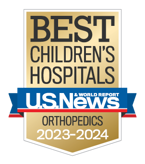Human Performance Lab
Nationally ranked by U.S. News & World Report

The way we walk and move our bodies is as unique to each of us as a fingerprint. The Human Performance Lab at the Children’s Mercy Sports Medicine Center at Village West uses 3D motion-capture technology to analyze your body, which can involve something as simple as observing the way you walk to capturing sport-specific motions such as jumping or throwing.
This allows our health care providers to make more informed and precise treatment recommendations for adolescents and children who need specialized care, including student-athletes who are recovering from injuries and children with neuromuscular disorders like cerebral palsy.
State-of-the-art technology
The 2,000-square foot motion analysis and human performance lab is part of the Children’s Mercy Sports Medicine Center at Village West. Features of the lab include:
- 19 different 3D cameras that use infrared rays to read sensors placed on the person’s body – the same technology used in movies and video games to create realistic graphics
- 16-channel wireless EMG system that measures electrical activity produced by muscle tissue when it contracts
- Six force plates installed in the floor to simulate walking on a sidewalk – measuring pressure as movement progresses from the heel to toe and calculating force on ankle, hip and knee joints
Movement analysis for every body
While the Children’s Mercy Sports Medicine Center at Village West is primarily geared towards training and rehabilitating athletes, the benefits of the Human Performance Lab extend to children with a variety of needs. Providers from the departments of Orthopedics, Neurology, Neurosurgery, and Rehabilitation Medicine all use the lab to guide treatment recommendations for children in their care. These include treatments such as physical therapy and orthopedic surgery.
The Human Performance Lab is not a diagnostic tool, but rather an assessment tool that helps the provider come up with a treatment plan. Data from the lab gives providers insights they can’t get from just observing the patient walk.
“3D Motion Capture and EMG together give us a full picture of how the patient is walking and moving, including forces and alignment. We’re able to view the patient’s walking from different angles to help us understand the nature of how the individual moves.” --Julie Musick, MS, PT, Director-PT/OT, Physical and Occupational Therapy.
In the lab, technicians can measure a child while walking barefoot or with one or more assistive devices, such as braces or a walker. This is helpful for children ages five and older with conditions like neuromuscular disorders, cerebral palsy, brain injuries, prematurity, or abnormal gait conditions.
3D Motion Capture and EMG together give us a full picture of how the patient is walking and moving, including forces and alignment. We’re able to view the patient’s walking from different angles to help us understand the nature of how the individual moves.
Advantages for athletes
Student-athletes who are recovering from an injury benefit from precision technology to get them back to play as soon as safely possible. The Human Performance Lab can analyze sport-specific movements such as pitching, kicking or throwing to help your care team determine how your healing is progressing.
Some student-athletes may not have an injury now, but the way they move could be putting them at greater risk for injuries in the future. By analyzing the student-athlete’s movements in the lab, we can make suggestions and recommendations for optimal wellness and performance.
Find Children’s Mercy Sports Medicine on social media
- Sports Medicine Center
- Adaptive Sports Medicine Program
- Athletic Training Services
- Concussion Treatment
- Full Athlete Care
- Human Performance Lab
- Injury Management
- Orthopedics
- Partnerships
- Pediatric Sports Medicine Fellowship
- Sports Medicine Surgery
- Sports Physical Therapy
- 360° Tour of Village West
- Meet the Sports Medicine Center Team
- Nominate Your Athlete



